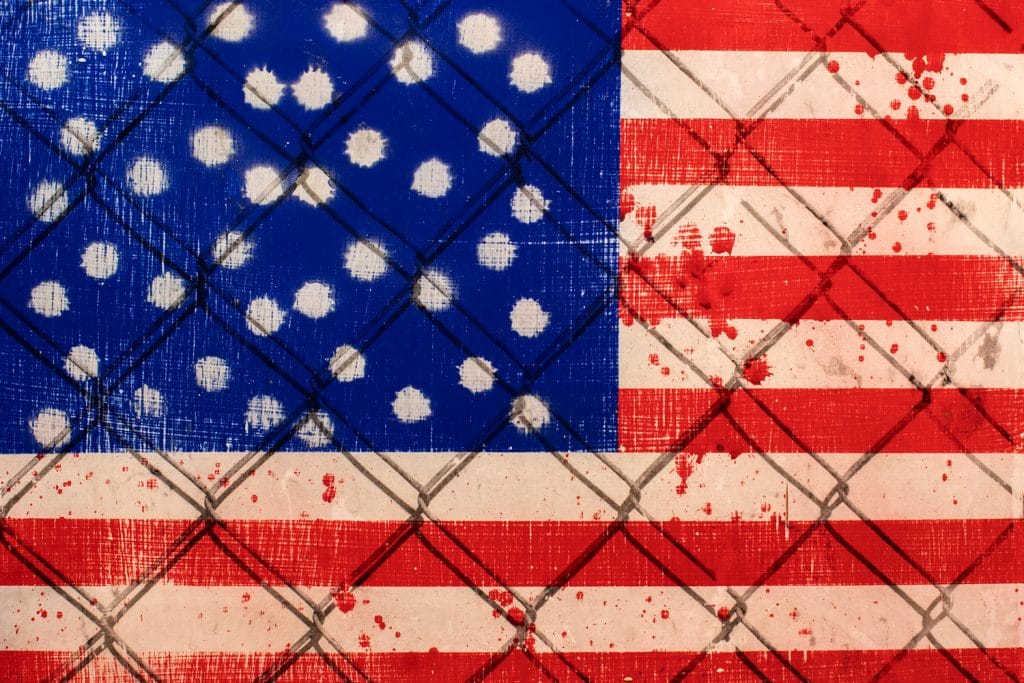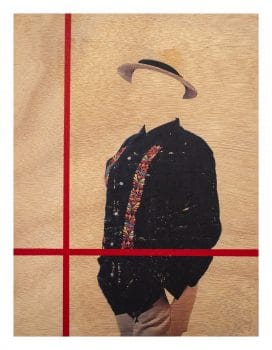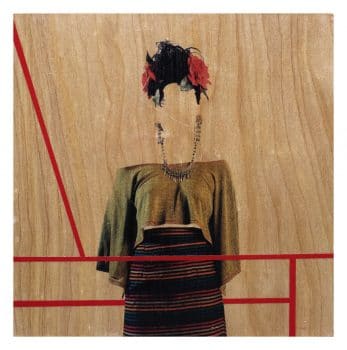The art exhibition, Perspectives, has opened at the Jean Deleage Art Gallery located in Casa0101 Theater in Boyle Heights. It is a debut for eight emerging young artists that includes an inter-visual conversation with visitors, communities and also between attendees. The exhibit includes traditional color and black and white photography, paintings, and image transfers onto wood panels are merged with experimental processes to create a dynamic conversation about technique, method and content.
Perspectives attempts to break free from the revolving door approach to past and current historical patterns of exclusion. Salon discussions facilitated by East Los Angeles College photography professor Mei Valenzuela and the participating artists prelude an exploration of ideas and assumptions of what shapes our opinion and perception of reality. Perspectives “took into consideration issues of identity, current political circumstances, adaptability to new environments, cultural imperial definitions of others, examination of western anthropological biases, the self-realization of class consciousness and cultural markers as points of inspiration.”
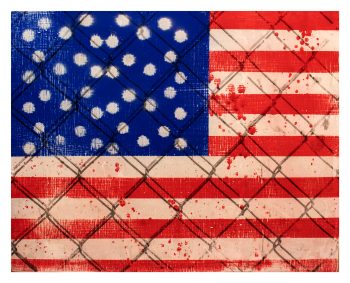 Artist Victor Garcia’s series Yo Soy American (I Am American) consists of image transfers onto nine wood panels. According to Garcia, who is of Mexican descent, his work is “an exploration of feelings and emotions of being a citizen of a country that doesn’t really want you.” Garcia’s expressive work consists of a series of brushed panels with red, blue and green paint layered with multiple images that make reference to the U.S and Mexico. The use of aerosol adds another dimension to his work. In the study of graphology, the over spray of aerosol dots and lines dripping across the series become points of hesitation. Garcia uses drops and smears metaphorically to express the uncertainties people of color feel when confronting questions of identity. For one guest at opening night, the dripping dots of paint were stains that could not be removed or bleached away, they are permanent. Does her observation allude to a discomfort brought about by the presence of Latin@s in the United States as a stain? Could that help explain the historical regressive policies of deportation, expatriation, operation wetback, the derogative literature against Mexicans, immigrants and Mexican Americans or the current xenophobic belief of making America great again, means without them (people of color)?
Artist Victor Garcia’s series Yo Soy American (I Am American) consists of image transfers onto nine wood panels. According to Garcia, who is of Mexican descent, his work is “an exploration of feelings and emotions of being a citizen of a country that doesn’t really want you.” Garcia’s expressive work consists of a series of brushed panels with red, blue and green paint layered with multiple images that make reference to the U.S and Mexico. The use of aerosol adds another dimension to his work. In the study of graphology, the over spray of aerosol dots and lines dripping across the series become points of hesitation. Garcia uses drops and smears metaphorically to express the uncertainties people of color feel when confronting questions of identity. For one guest at opening night, the dripping dots of paint were stains that could not be removed or bleached away, they are permanent. Does her observation allude to a discomfort brought about by the presence of Latin@s in the United States as a stain? Could that help explain the historical regressive policies of deportation, expatriation, operation wetback, the derogative literature against Mexicans, immigrants and Mexican Americans or the current xenophobic belief of making America great again, means without them (people of color)?
Garcia’s series highlights the imposition of racism as an insidious paradigm, defining who is, and what makes, an “American.” Is racism a reaction of fear, dis-empowerment; or is it simply an expression of the arrogance of power? By exposing paradigms of exclusion, his artwork highlights the limitations of how racalization is approached not excluding Latin@s/Chicano@s/ and Mexican Americans who search for solutions exclusively through a Western lens. After all, racial classifications and the construction of the other as subjects (non-Euro) began with colonization. Instead he seeks to widen the aperture and allow the entry of more light to contest discriminating practices.
In one part of Garcia’s exhibit, four wood panels with faceless full body portraits of people dressed between with a mix of indigenous and contemporary clothing, in affirmation of the sense of duality felt by Latin@s/Chicano@s/ and Mexican Americans. Two of those portraits with thin red lines around the edge of the frame mark a binary contradiction between who is visible and who is not. In Beyond Abysmal Thinking philosopher Boaventura de Sousa Santos points to such contradictions as un-natural developments against differences justified by western modern law and modern knowledge. Can the faceless also suggest the approximately twelve to fifteen million people whose ‘Legal’ status in the U.S. is detained in an ambiguous perpetual state of invisibility?
Although not directly emphasized the red vertical and horizonal lines also reminds the once upon a time of mapped areas of the city of Los Angeles redlined to systematic deny specific nonwhite groups from purchasing homes, property or obtain services. According to a recent article on the Washington Post despite the ban on discrimination 50 years ago the consequences of redlining neighborhoods continue to struggle economically today (“Redlining was banned 50 years ago. It’s still hurting minorities today,” March 28, 2018).
Garcia’s bilingual title Yo Soy American for this series counters the hegemonic categorization ‘Hispanic’ that came about during the Reagan era to assimilate and coral Spanish and non-Spanish speaking Latin@s under one label. Instead he amplifies and discovers multiple ways of being Latin@/Chican@ and Mexican American that does not minus from being a person and an American. The whitewashing definition Hispanic is emphasized in his work with strokes of white paint as a backdrop superimposed with portraits of family members allowing aspects of his cultural Mexican-ness (mexicanidad) to permeate. He breaks the encirclement of stereotypes by allowing Mexican American history to count itself in as a contributor in the making of the United State and the role it has played as an advocate of social justice. His presentation is an “act of visual rebellion,” thawing histories buried beneath tons of I.C.E with a skilled, technical method that strongly conveys his reflective intellect and sense of dignity.
By displaying the layers of contradictions embedded in Garcia’s own identity visually, the viewer begins to feel the caustic reality of racism: the persistent reminder of inferiority; the impossibility of non-biased, non-prejudiced conviviality in diverse environments; the devaluation and dissolution of cultural particularity; the slow, painful erosion of confidence and self-esteem…. The combined effect on people of color is that any healthy, constructive means of navigating U.S. society is removed, cut off. Martin Luther King Jr.’s dream of future generations not being judged “by the color of their skin, but by the content of their character” seems far away indeed.
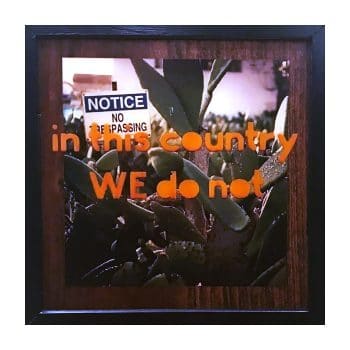 In a piece titled, Face the Fallacy—the only one with any text at all—a cactus tree forms the background and the foreground reads, “In this country we do not….” For Garcia, the phrase alludes to an incident in which he accidentally blocked an intersection with his vehicle. At one point a white male rolled his window down and said to Garcia, “In this country we do not….” The incomplete text stuns after a few rereads, when the force juxtaposition of discomfort and bias in those words hits home. The immortalization of racist reaction in this piece of art is a stark reminder of the wide prevalence of racial profiling in society today. It recalls a the prescient words of the great black sociologist, W.E.B Du Bois, in 1903: “The problem of the Twentieth Century is the problem of the color-line” (The Souls of Black Folk, p. 3).
In a piece titled, Face the Fallacy—the only one with any text at all—a cactus tree forms the background and the foreground reads, “In this country we do not….” For Garcia, the phrase alludes to an incident in which he accidentally blocked an intersection with his vehicle. At one point a white male rolled his window down and said to Garcia, “In this country we do not….” The incomplete text stuns after a few rereads, when the force juxtaposition of discomfort and bias in those words hits home. The immortalization of racist reaction in this piece of art is a stark reminder of the wide prevalence of racial profiling in society today. It recalls a the prescient words of the great black sociologist, W.E.B Du Bois, in 1903: “The problem of the Twentieth Century is the problem of the color-line” (The Souls of Black Folk, p. 3).
The core questions posed in Garcia’s work are:
- What are the building blocks of perception that justify and rationalize white(ness) superiority over others?
- Is racism the continuation of a provincial Eurocentric method of codifying between civil (Euro) and uncivil (non-European) an extension of colonization?
- How did the provincial Eurocentric local and regional belief of superiority (higher civilization) become a natural… universal (global)… racialized… social classification and “not a consequence of a history of power” (in the words of Aníbal Quijano, from his extraordinary essay “Coloniality of Power, Eurocentrism and Latin America”)?
Further into his work—in a more humorous and positive take on the “In this country we do not…” incident—Garcia explains that the cactus tree behind the text is an ancient, pre-Colombian symbol for Mexican culture. “Guess what,” he says, “Nopales (cactus) do grow here [in the U.S.] and we do eat them too!”
Garcia’s work is highly reflective, even as it condemns. His series ultimately serves to encourage, not cease, the critical conversations that can eventually help us find ways of coexisting together.
Perspective can be viewed until October 25,2018. For more information please visit www.casa0101.org or email curator [at] casa0101.org.
This essay is dedicated to the Marxist sociologist, Aníbal Quijano (November 17, 1928–May 31, 2018)

